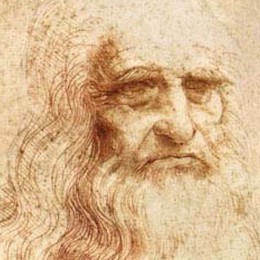Léonard De Vinci
1452 (Vinci, près de Florence) / 1519 (château de Cloux, aujourd'hui Clos-Lucé, près d'Amboise)
The iconic figure of Leonardo da Vinci is undoubtedly understood through the addition of his fields of investigation. Painter and mathematician, thinker and architect, his works bear witness to his universal spirit, a pivotal point between the late quattrocento, whose research Leonardo surpassed and renewed, and the early 16th century. Some thirty painted works attributable with certainty, sometimes unfinished, trace his career, while his notebooks are filled with sketches: so many inventions, machinery, diagrams, and anatomies sketching the modern image of man observing and transforming his environment. From Florence to the shores of the Loire, through the prestigious and decisive stage in Milan, the rigorous observation of nature competes in his painting with the gracefulness of the sfumato with which he surrounds, like a halo, the enigmatic figures of his Virgins.
The iconic figure of Leonardo da Vinci is undoubtedly understood through the addition of his fields of investigation. Painter and mathematician, thinker and architect, his works bear witness to his universal spirit, a pivotal point between the late quattrocento, whose research Leonardo surpassed and renewed, and the early 16th century. Some thirty painted works attributable with certainty, sometimes unfinished, trace his career, while his notebooks are filled with sketches: so many inventions, machinery, diagrams, and anatomies sketching the modern image of man observing and transforming his environment. From Florence to the shores of the Loire, through the prestigious and decisive stage in Milan, the rigorous observation of nature competes in his painting with the gracefulness of the sfumato with which he surrounds, like a halo, the enigmatic figures of his Virgins.
Artist's exhibitions
Gribouillage / Scarabocchio. De Léonard de Vinci à Cy Twombly.
14/02/2023 - 30/04/2023
(Paris) Palais des Beaux-Arts
14/02/2023 - 30/04/2023
(Paris) Palais des Beaux-Arts
Saison Viva Leonardo da Vinci ! – 500 ans de Renaissance(s)
10/03/2019 - 31/12/2019
(Chambord) Château de Chambord
10/03/2019 - 31/12/2019
(Chambord) Château de Chambord
Les Borgia et leur temps, de Léonard de Vinci à Michel-Ange
17/09/2014 - 15/02/2015
(Paris) Musée Maillol
17/09/2014 - 15/02/2015
(Paris) Musée Maillol
Fra Angelico, Botticelli… – Chefs-d’œuvre retrouvés
08/09/2014 - 05/01/2015
(Chantilly) Château de Chantilly
08/09/2014 - 05/01/2015
(Chantilly) Château de Chantilly
Bohèmes
26/09/2012 - 14/01/2013
(Paris) Grand Palais
26/09/2012 - 14/01/2013
(Paris) Grand Palais
La Sainte Anne, l’ultime chef-d’œuvre de Léonard de Vinci
29/03/2012 - 25/06/2012
(Paris) Musée du Louvre
29/03/2012 - 25/06/2012
(Paris) Musée du Louvre
Leonardo da Vinci: Painter at the Court of Milan
09/11/2011 - 05/02/2012
(Londres) National Gallery
09/11/2011 - 05/02/2012
(Londres) National Gallery
